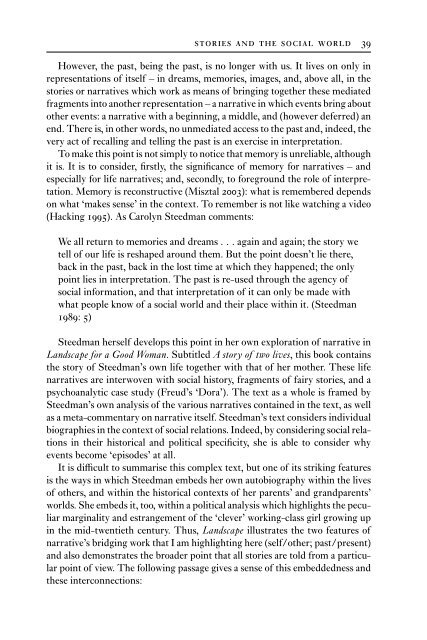Research Methods for Cultural Studies
Research Methods for Cultural Studies
Research Methods for Cultural Studies
Create successful ePaper yourself
Turn your PDF publications into a flip-book with our unique Google optimized e-Paper software.
stories and the social world 39<br />
However, the past, being the past, is no longer with us. It lives on only in<br />
representations of itself – in dreams, memories, images, and, above all, in the<br />
stories or narratives which work as means of bringing together these mediated<br />
fragments into another representation – a narrative in which events bring about<br />
other events: a narrative with a beginning, a middle, and (however deferred) an<br />
end. There is, in other words, no unmediated access to the past and, indeed, the<br />
very act of recalling and telling the past is an exercise in interpretation.<br />
To make this point is not simply to notice that memory is unreliable, although<br />
it is. It is to consider, firstly, the significance of memory <strong>for</strong> narratives – and<br />
especially <strong>for</strong> life narratives; and, secondly, to <strong>for</strong>eground the role of interpretation.<br />
Memory is reconstructive (Misztal 2003): what is remembered depends<br />
on what ‘makes sense’ in the context. To remember is not like watching a video<br />
(Hacking 1995). As Carolyn Steedman comments:<br />
We all return to memories and dreams . . . again and again; the story we<br />
tell of our life is reshaped around them. But the point doesn’t lie there,<br />
back in the past, back in the lost time at which they happened; the only<br />
point lies in interpretation. The past is re-used through the agency of<br />
social in<strong>for</strong>mation, and that interpretation of it can only be made with<br />
what people know of a social world and their place within it. (Steedman<br />
1989: 5)<br />
Steedman herself develops this point in her own exploration of narrative in<br />
Landscape <strong>for</strong> a Good Woman. Subtitled A story of two lives, this book contains<br />
the story of Steedman’s own life together with that of her mother. These life<br />
narratives are interwoven with social history, fragments of fairy stories, and a<br />
psychoanalytic case study (Freud’s ‘Dora’). The text as a whole is framed by<br />
Steedman’s own analysis of the various narratives contained in the text, as well<br />
as a meta-commentary on narrative itself. Steedman’s text considers individual<br />
biographies in the context of social relations. Indeed, by considering social relations<br />
in their historical and political specificity, she is able to consider why<br />
events become ‘episodes’ at all.<br />
It is difficult to summarise this complex text, but one of its striking features<br />
is the ways in which Steedman embeds her own autobiography within the lives<br />
of others, and within the historical contexts of her parents’ and grandparents’<br />
worlds. She embeds it, too, within a political analysis which highlights the peculiar<br />
marginality and estrangement of the ‘clever’ working-class girl growing up<br />
in the mid-twentieth century. Thus, Landscape illustrates the two features of<br />
narrative’s bridging work that I am highlighting here (self/other; past/present)<br />
and also demonstrates the broader point that all stories are told from a particular<br />
point of view. The following passage gives a sense of this embeddedness and<br />
these interconnections:


